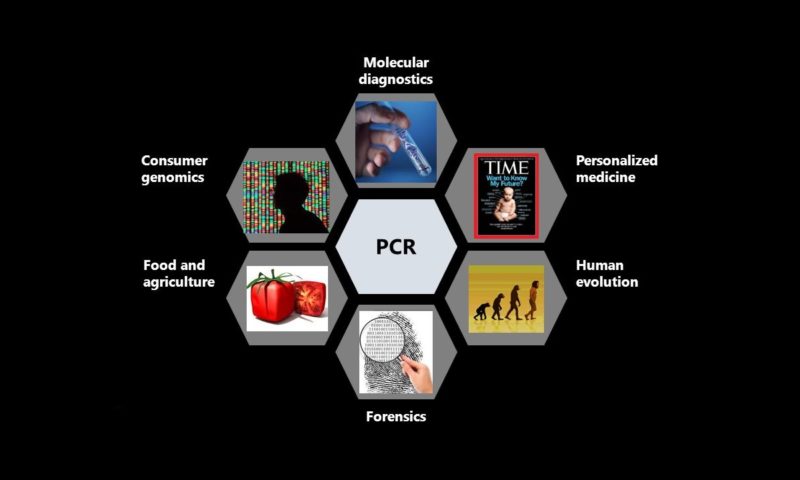Introduction:
Reverse Transcription – quantitative PCR (RT-qPCR) is performed when the start material is an RNA. It is used for analysing gene expression and quantitating RNA. This method has high sensitivity and has no post amplification processing and hence it is amenable to heightening sample throughput. This method involves amplification and detection at the single step using fluorescent dye that is SYBR green. This method has plethora of benefits which includes:
- 10,000 times more sensitive than the usual RNase protection assay
- Give more accurate and dynamic data with 7 to 8 logs of order magnitude
- More reliable than primitive dot blot assays
Principle:
RT-PCR was developed to amplify and analyse RNA targets. Essentially, the method has an initial step of transcribing a portion of the RNA genome into complementary DNA (cDNA) which is then amplified through PCR.
PCR depends on the Taq Polymerase enzyme; RNA is not an efficient substrate for this enzyme. This is why the target of interest (if present) is first transcribed into complementary DNA (cDNA) by using reverse transcriptase enzyme, which can then be amplified. Quantitative PCR (qPCR) or Real-time PCR detects the DNA fragments as PCR amplifies it, and provides quantification data for analysis by the user.
RT-PCR can be performed as one or two step procedures depending upon the requirement. In a one-step procedure, the reverse transcriptase is performed in the same reaction tube as the polymerase chain reaction, usually one step gives high efficiency. In a two-step procedure, transcription of the RNA to cDNA is performed first. Transcription occurs between 40°C and 50°C, depending on the properties of the reverse transcriptase enzyme utilized; products of that reaction are then amplified in a separate reaction, this type has a chance of losing RNA while transferring the samples.
Materials Required:
Chemicals: Reverse transcriptase, mRNA, Buffer, dNTPs, Sequence specific Forward and Reverse primers, Oligo(dT) Primers, SYBR green dye master mix, DNA Polymerase, dH2O (RNase free), TES buffer, Acid phenol: Chloroform, Absolute Ethyl Alcohol, MgCl2.
Consumables: Microfuge tubes 1.5 ml, test tubes
Instruments: Thermocycler, Spectrophotometer, Centrifuge, Vortex mixer
Methodology:
- RNA extraction and Purification
- Collect 19-20 ml of cell culture (from the sample), wash these cells with RNase free dH2O and transfer in 1.5 ml micro-centrifuge tubes. Pellet down the cells and remove supernatant (Cells can be stored at -80˚C)
- Re-suspend the pellet in 400 ul of TES Buffer and 400 ul of phenol: Chloroform, vortex for 10 seconds and incubate for 1 Hour at 65˚C in a shaker
- Centrifuge the mixture at max speed for 10 mins at 4˚C
- Transfer the upper aqueous layer and repeat the above steps (to obtain debris free RNA)
- Add 200 ul of TE buffer and 400 ul of chloroform to the sample, vortex for 10 sec and transfer the upper aqueous layer in another clean 1.5 ml micro-centrifuge tube
- Precipitate RNA with absolute ethanol. Incubate overnight at -80˚C
- Pellet RNA at max speed for 15 mins at 4˚, dry the pellet at room temperature. Re-suspend pellet in 10-100 ul of RNase free dH2O
- Determine the purity by spectrophotometer (Samples should have following ratios for protein and organic solvent contamination respectively: 260/280 > 1.7 and 260/230 > 2.0)
- cDNA Synthesis and quantification of DNA
- Program a real-time instrument for standard or fast mode one-step RT-qPCR.
- Mix RNA Sample, Site specific primers, Reverse transcriptase enzyme and other qPCR compatible diluents.
- Prepare Standards and control, Primer pair 1X concentration
- Combine above reaction mixtures in a non-stick sterile on ice. Mix gently and gently and pipette reaction carefully into the plate on ice.
- Transferred plate from ice into the programmed thermal cycler instrument and start the run.
- After the run is complete, remove the sample and analyse the data using thermal cycler detection software. Quantification is done by checking the fluorescence of SYBR green dye.
Conclusion:
Researchers can study gene transcription using RT-qPCR which involves exploiting the ability of reverse transcriptase to synthesize complementary DNA (cDNA) from mRNA transcripts, and then using PCR to amplify regions of interest. An important step in RT-qPCR is the purification of mRNA from the cell extracts. Without this purification step, genomic DNA can contaminate the PCR reaction and become amplified along with mRNA. Like other DNA polymerases, reverse transcriptase requires a primer. Researchers must take care not to contaminate their RNA samples with widely prevalent RNase enzymes, which degrade RNA and can ruin experiments. Inhibitors of RNase can be used to prevent such degradation in the case of RNase contamination.



